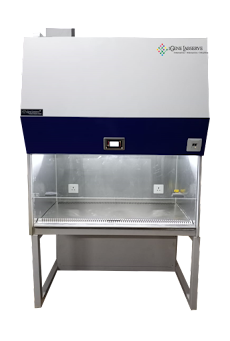As it screens both the intake and exhaust air, a biological safety cabinet (BSC) is a fundamental engineering control that guards workers against infectious or biohazardous materials while also assisting in maintaining material quality control. It is also known as a culture vessel for tissue hood or laminar flow.
A biosafety cabinet is primarily used to guard against exposure to particles or aerosols. Most BSCs use an exhaust HEPA filter to circulate some of the air back into the research facility. This removes animal dander, possibly infectious particles, or both from the air, but it does not lessen the exposure to chemicals.
What is the working principle of these cabinets?
The basic idea behind how biosafety cabinets operate is to draw air from within them so that they maintain a low-pressure environment and provide vertical airflow to safeguard personnel. To prevent contaminating the analyzed samples, external air undergoes filtering using an air filter (high-efficiency particulate air filter or HEPA filter) before entering the biosafety cabinet. To safeguard the environment, the air within the biological safety cabinet must also pass through a HEPA filter before being released into the atmosphere.
What is the function of these filter cabinets?
This section will explain the purpose of these biosafety cabinets once you have a firm understanding of their usage and philosophy. The safety cabinet's primary purpose is to shield the environment and the researcher from the negative pressure generated by the filtration fume hood that produces bioaerosols during the experiment. The primary piece of equipment for preventing laboratory-acquired infections is the biosafety cabinet class 2.
Types of biosafety cabinets
Depending on the biological safety protection, these biosafety cabinets can be divided into three types.
Let’s discuss them a bit to understand how those works.
Biosafety Cabinet Class I
Despite preserving samples, class I biosafety cabinets safeguard both the environment and employees. A typical kitchen in a research facility operates on an identical airflow basis. The filter attached to the emission port is what makes a difference.
The fan in the exterior vent pipe drives the airflow in the first-class biological safety cabinet as it lacks a fan of its own. It is currently seldom utilized since it cannot safeguard test objects or products.
Biosafety Cabinet Class II
Based on the input air velocity, emission mode, and circulation mode, the class II biological safety cabinet may be separated into four levels: Type A1, Type A2, Type B1, and Type B2. Products, personnel, and the environment are all protected in Class II biosafety cabinets.
Biosafety Cabinet Class III
Labs with a biological safety protection level of 4 are intended for use with Class III biosafety cabinets. There is no air leakage in the biosafety cabinet class ii type a2 specification. To guarantee there is no contamination, the test goods enter and leave the safety cabinet through the double-door transfer box, and the personnel works using gloves that are attached to the cabinet.
Biosafety cabinets classified as class III are appropriate for high-risk biological investigations, including those involving the SARS and Ebola viruses.
If you want to buy any of these biosafety cabinets for research purposes, look no further than iGene Labserve.
Go to our website (https://www.igenels.com/) to check our biosafety cabinet types. For enquiries, reach us at 18005720603 and info@igenels.com.





No comments:
Post a Comment